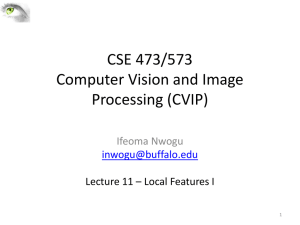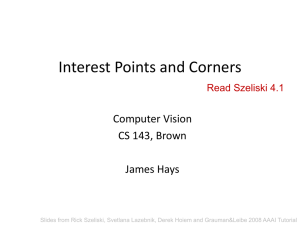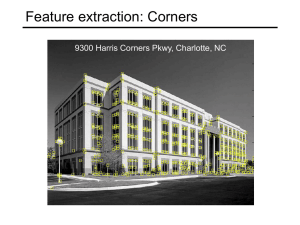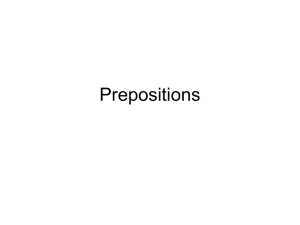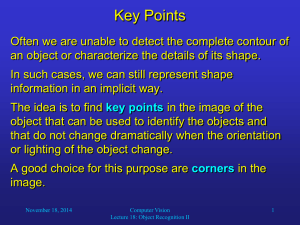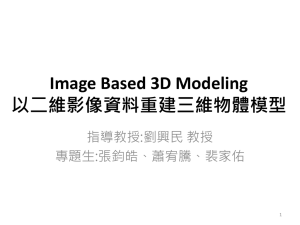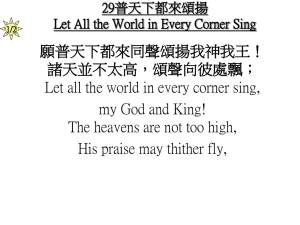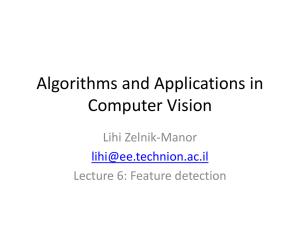PPT
advertisement
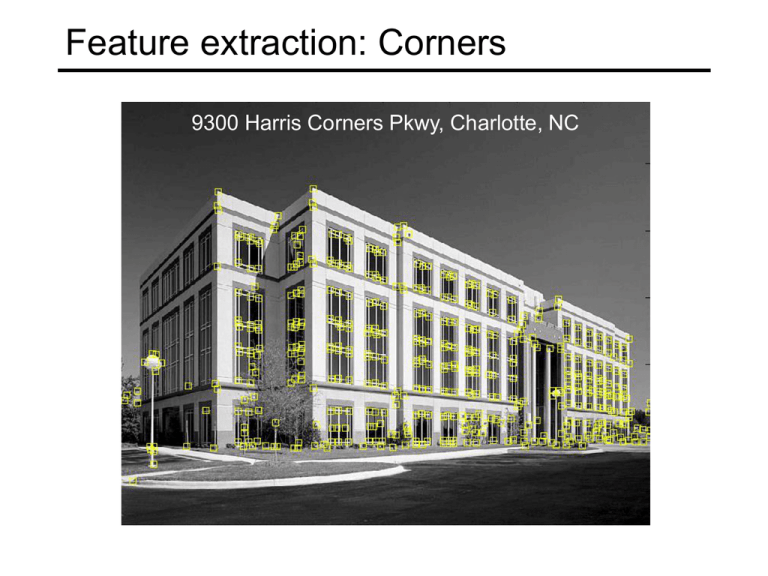
Feature extraction: Corners 9300 Harris Corners Pkwy, Charlotte, NC Why extract features? • Motivation: panorama stitching • We have two images – how do we combine them? Why extract features? • Motivation: panorama stitching • We have two images – how do we combine them? Step 1: extract features Step 2: match features Why extract features? • Motivation: panorama stitching • We have two images – how do we combine them? Step 1: extract features Step 2: match features Step 3: align images Characteristics of good features • Repeatability • The same feature can be found in several images despite geometric and photometric transformations • Saliency • Each feature is distinctive • Compactness and efficiency • Many fewer features than image pixels • Locality • A feature occupies a relatively small area of the image; robust to clutter and occlusion Applications Feature points are used for: • • • • • • Image alignment 3D reconstruction Motion tracking Robot navigation Indexing and database retrieval Object recognition A hard feature matching problem NASA Mars Rover images Answer below (look for tiny colored squares…) NASA Mars Rover images with SIFT feature matches Figure by Noah Snavely Corner Detection: Basic Idea • We should easily recognize the point by looking through a small window • Shifting a window in any direction should give a large change in intensity “flat” region: no change in all directions “edge”: no change along the edge direction “corner”: significant change in all directions Corner Detection: Mathematics Change in appearance of window W for the shift [u,v]: E (u , v ) [ I ( x u , y v ) I ( x , y )] ( x , y )W I(x, y) E(u, v) E(3,2) 2 Corner Detection: Mathematics Change in appearance of window W for the shift [u,v]: E (u , v ) [ I ( x u , y v ) I ( x , y )] ( x , y )W I(x, y) E(u, v) E(0,0) 2 Corner Detection: Mathematics Change in appearance of window W for the shift [u,v]: E (u , v ) [ I ( x u , y v ) I ( x , y )] 2 ( x , y )W We want to find out how this function behaves for small shifts E(u, v) Corner Detection: Mathematics • First-order Taylor approximation for small motions [u, v]: I ( x u , y v) I ( x, y ) I xu I y v • Let’s plug this into E(u,v): E (u , v ) [ I ( x u , y v ) I ( x , y )] 2 ( x , y )W [ I ( x, y ) I x u I y v I ( x , y )] 2 ( x , y )W [I ( x , y )W u I yv] 2 x I ( x , y )W 2 x u 2 I x I y uv I v 2 2 y 2 Corner Detection: Mathematics The quadratic approximation can be written as E ( u , v ) u u vM v where M is a second moment matrix computed from image derivatives: I x2 x,y M IxI y x , y I x,y x,y Iy 2 Iy x (the sums are over all the pixels in the window W) Interpreting the second moment matrix • The surface E(u,v) is locally approximated by a quadratic form. Let’s try to understand its shape. • Specifically, in which directions does it have the smallest/greatest change? u E (u , v ) [u v ] M v I x2 x,y M IxI y x , y I x,y x,y Iy 2 Iy x E(u, v) Interpreting the second moment matrix First, consider the axis-aligned case (gradients are either horizontal or vertical) I x2 x, y M IxIy x , y I x,y x,y Iy 2 Iy x a 0 0 b If either a or b is close to 0, then this is not a corner, so look for locations where both are large. Interpreting the second moment matrix Consider a horizontal “slice” of E(u, v): This is the equation of an ellipse. u [ u v ] M const v Interpreting the second moment matrix Consider a horizontal “slice” of E(u, v): u [ u v ] M const v This is the equation of an ellipse. Diagonalization of M: M R 1 1 0 0 R 2 The axis lengths of the ellipse are determined by the eigenvalues and the orientation is determined by R direction of the fastest change direction of the slowest change (max)-1/2 (min)-1/2 Visualization of second moment matrices Visualization of second moment matrices Interpreting the eigenvalues Classification of image points using eigenvalues of M: 2 “Edge” 2 >> 1 “Corner” 1 and 2 are large, 1 ~ 2 ; E increases in all directions 1 and 2 are small; E is almost constant in all directions “Flat” region “Edge” 1 >> 2 1 Corner response function R det( M ) trace ( M ) 1 2 ( 1 2 ) 2 α: constant (0.04 to 0.06) “Edge” R<0 2 “Corner” R>0 |R| small “Flat” region “Edge” R<0 The Harris corner detector 1. Compute partial derivatives at each pixel 2. Compute second moment matrix M in a Gaussian window around each pixel: w ( x , y ) I x2 x,y M w( x, y ) I x I y x , y w( x, y ) I x,y x,y Iy 2 w( x, y ) I y x C.Harris and M.Stephens. “A Combined Corner and Edge Detector.” Proceedings of the 4th Alvey Vision Conference: pages 147—151, 1988. The Harris corner detector 1. Compute partial derivatives at each pixel 2. Compute second moment matrix M in a Gaussian window around each pixel 3. Compute corner response function R C.Harris and M.Stephens. “A Combined Corner and Edge Detector.” Proceedings of the 4th Alvey Vision Conference: pages 147—151, 1988. Harris Detector: Steps Harris Detector: Steps Compute corner response R The Harris corner detector 1. Compute partial derivatives at each pixel 2. Compute second moment matrix M in a Gaussian window around each pixel 3. Compute corner response function R 4. Threshold R 5. Find local maxima of response function (nonmaximum suppression) C.Harris and M.Stephens. “A Combined Corner and Edge Detector.” Proceedings of the 4th Alvey Vision Conference: pages 147—151, 1988. Harris Detector: Steps Find points with large corner response: R > threshold Harris Detector: Steps Take only the points of local maxima of R Harris Detector: Steps Invariance and covariance • We want corner locations to be invariant to photometric transformations and covariant to geometric transformations • Invariance: image is transformed and corner locations do not change • Covariance: if we have two transformed versions of the same image, features should be detected in corresponding locations Affine intensity change IaI+b • Only derivatives are used => invariance to intensity shift I I + b • Intensity scaling: I a I R R threshold x (image coordinate) x (image coordinate) Partially invariant to affine intensity change Image translation • Derivatives and window function are shift-invariant Corner location is covariant w.r.t. translation Image rotation Second moment ellipse rotates but its shape (i.e. eigenvalues) remains the same Corner location is covariant w.r.t. rotation Scaling Corner All points will be classified as edges Corner location is not covariant to scaling!

